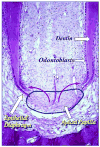Characterization of the apical papilla and its residing stem cells from human immature permanent teeth: a pilot study
- PMID: 18215674
- PMCID: PMC2714367
- DOI: 10.1016/j.joen.2007.11.021
Characterization of the apical papilla and its residing stem cells from human immature permanent teeth: a pilot study
Abstract
Mesenchymal stem cells (MSCs) have been isolated from the pulp tissue of permanent teeth (dental pulp stem cells or DPSCs) and deciduous teeth (stem cells from human exfoliated deciduous teeth). We recently discovered another type of MSCs in the apical papilla of human immature permanent teeth termed stem cells from the apical papilla (SCAP). Here, we further characterized the apical papilla tissue and stem cell properties of SCAP using histologic, immunohistochemical, and immunocytofluorescent analyses. We found that the apical papilla is distinctive to the pulp in terms of containing less cellular and vascular components than those in the pulp. Cells in the apical papilla proliferated 2- to 3-fold greater than those in the pulp in organ cultures. Both SCAP and DPSCs were as potent in osteo/dentinogenic differentiation as MSCs from bone marrows, whereas they were weaker in adipogenic potential. The immunophenotype of SCAP is similar to that of DPSCs on the osteo/dentinogenic and growth factor receptor gene profiles. Double-staining experiments showed that STRO-1 coexpressed with dentinogenic markers such as bone sialophosphoprotein, osteocalcin, and growth factors FGFR1 and TGFbetaRI in cultured SCAP. Additionally, SCAP express a wide variety of neurogenic markers such as nestin and neurofilament M upon stimulation with a neurogenic medium. We conclude that SCAP are similar to DPSCs but a distinct source of potent dental stem/progenitor cells. Their implications in root development and apexogenesis are discussed.
Figures







References
-
- D’Souza R. Development of the pulpodentin complex. In: Goodis KMHaHE., editor. Seltzer and Bender’s Dental Pulp. Quintessence Publishing Co, Inc; Carol Stream, IL: 2002.
-
- Sonoyama W, Seo BM, Yamaza T, Shi S. Human Hertwig’s Epithelial Root Sheath Cells Play Crucial Roles in Cementum Formation. J Dent Res. 2007;86:594–9. - PubMed
Publication types
MeSH terms
Substances
Grants and funding
LinkOut - more resources
Full Text Sources
Other Literature Sources
Miscellaneous

